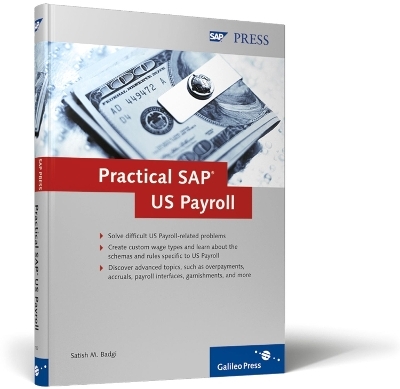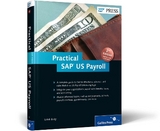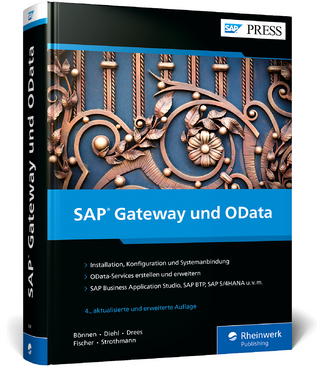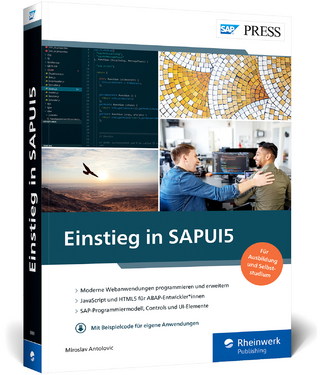
Practical SAP US Payroll
SAP Press (Verlag)
978-1-59229-132-8 (ISBN)
- Titel ist leider vergriffen;
keine Neuauflage - Artikel merken
Satish Badgi has been involved in the US payroll market for over 10 years. His implementations of SAP HR/Payroll cover many industries, such as manufacturing, public sector, utilities, and finance. In addition, he has conducted training courses for customers in the HR and Payroll area, and is a regular presenter at ASUG conferences and events. Satish also writes for HRExpert newsletter and the SAPTips community.
Contents Preface ... 13 1 Objectives and Purpose ... 19 ... 1.1 What Makes US Payroll Unique ... 20 ... 1.1.1 Functional Uniqueness ... 20 ... 1.1.2 Technical Uniqueness ... 23 ... 1.2 The US Payroll Process ... 24 ... 1.3 Components of SAP US Payroll ... 26 ... 1.4 Summary ... 27 2 US Payroll Infotypes: Master Data and Transaction Data ... 29 ... 2.1 Master Data: Conceptual Clarity ... 29 ... 2.2 Retroactive Accounting ... 30 ... 2.3 Employee Master Data for US Payroll ... 32 ... 2.3.1 Infotype 0008: Basic Pay ... 35 ... 2.3.2 Infotype 0009: Bank Details ... 36 ... 2.3.3 Infotype 2010: Employee Remuneration ... 37 ... 2.3.4 Infotype 0207: Residence Tax ... 38 ... 2.3.5 Infotype 0208: Work Tax ... 38 ... 2.3.6 Infotype 0167: Health Plans ... 39 ... 2.3.7 Infotype 0057: Membership Fees ... 39 ... 2.4 Employee Transaction Data: US Payroll ... 40 ... 2.4.1 Infotype 0014: Earnings/Deductions Transaction Data ... 44 ... 2.4.2 Infotype 0169: Savings Plans ... 44 ... 2.4.3 Infotype 0015: Additional Payments and Deductions ... 45 ... 2.4.4 Infotype 0267: Bonus and Off Cycle ... 45 ... 2.4.5 Infotype 0011: External Bank Transfer ... 46 ... 2.4.6 Infotype 0210: Changes to W-4 Data ... 47 ... 2.5 Pre-Payroll Data Verification ... 47 ... 2.6 Summary ... 50 3 Wage Types 51 ... 3.1 Overview of a US Paystub and the Concept of Wage Types ... 51 ... 3.2 Lifecycle of a Wage Type and US Wage Type Catalog ... 54 ... 3.2.1 Wage Type Categories ... 58 ... 3.2.2 Three Elements of a Wage Type ... 59 ... 3.2.3 Wage Type Catalog ... 61 ... 3.3 Step-by-Step Configuration of a Wage Type ... 63 ... 3.3.1 Earnings ... 64 ... 3.3.2 Deductions ... 72 ... 3.3.3 Taxes ... 78 ... 3.3.4 Net Pay ... 82 ... 3.4 Testing Wage Types ... 84 ... 3.5 Advanced Topics on Wage Types ... 88 ... 3.5.1 Handling Cumulations ... 88 ... 3.5.2 Setting Up Payment Models ... 90 ... 3.5.3 Priority and Arrears ... 91 ... 3.5.4 Posting of Wage Types ... 96 ... 3.6 Summary ... 98 4 Schemas and Rules ... 99 ... 4.1 Examining the US Payroll Driver (RPCALCU0) ... 99 ... 4.2 Working with US Schema U000 ... 101 ... 4.2.1 Schema ... 104 ... 4.2.2 Subschemas ... 104 ... 4.2.3 US Subschemas ... 106 ... 4.3 Why, When, and How to Change the US Schema 119 ... 4.3.1 Copy and Modify U000 using the Schema Editor ... 120 ... 4.3.2 Running an Error-Free Schema ... 121 ... 4.4 Overview of the US Public Sector Schema functionality ... 126 ... 4.4.1 NRA: Non-Resident Alien Processing ... 126 ... 4.4.2 Savings Bonds Processing ... 127 ... 4.4.3 Public Sector Savings Plans: 403(B), 457(B) ... 127 ... 4.4.4 Employer Benefits and Tax Allocation Rules ... 128 ... 4.5 Writing Rules in US Payroll ... 128 ... 4.5.1 The Rules Editor ... 129 ... 4.5.2 Creating a Simple Rule 131 ... 4.5.3 Creating Complex Rules ... 135 ... 4.5.4 Running Error-Free Rules ... 140 ... 4.6 Summary ... 143 5 Benefits Integration ... 145 ... 5.1 Integration of US Benefits with US Payroll ... 145 ... 5.1.1 Processing ... 147 ... 5.1.2 Output ... 147 ... 5.2 Health Plan Integration ... 148 ... 5.2.1 Health Plans ... 149 ... 5.3 Savings Plan Integration ... 153 ... 5.3.1 Savings Plans ... 153 ... 5.4 Insurance Plan Integration ... 160 ... 5.5 Flexible Spending Account Integration ... 164 ... 5.6 Sending Data and Remittance to Benefit Providers ... 167 ... 5.6.1 Health Plans ... 167 ... 5.6.2 Insurance Plans ... 167 ... 5.6.3 Savings Plans ... 168 ... 5.6.4 Sending Remittance ... 168 ... 5.6.5 Sending Data ... 169 ... 5.7 Summary ... 169 6 Garnishments ... 171 ... 6.1 Configuring Garnishments ... 172 ... 6.1.1 Garnishment Infotypes ... 172 ... 6.2 Disposable Net Income ... 176 ... 6.2.1 Definition of Disposable Net Income ... 176 ... 6.2.2 Example ... 178 ... 6.3 Managing Wage Types for Garnishments ... 180 ... 6.3.1 Garnishment Deduction Wage Types ... 180 ... 6.3.2 Impact of Other Wage Types ... 181 ... 6.4 Garnishment Subschema ... 181 ... 6.4.1 Rule UGIT ... 182 ... 6.4.2 Rule UGDN ... 184 ... 6.4.3 Function UGARN ... 186 ... 6.5 Summary ... 187 7 Tax Processing ... 189 ... 7.1 Introduction to US Tax Processing ... 189 ... 7.1.1 Tax Infotypes ... 190 ... 7.1.2 Earnings and Deductions ... 192 ... 7.1.3 Relevant Processing Classes for Wage Types ... 193 ... 7.2 Tax Models ... 194 ... 7.2.1 Tax Authorities ... 194 ... 7.2.2 Tax Areas ... 195 ... 7.2.3 Tax Types ... 196 ... 7.2.4 Tax Class ... 197 ... 7.2.5 Tax Models ... 197 ... 7.3 Year-End Tax Adjustments and Workbench ... 202 ... 7.3.1 Starting the Year-End Workbench ... 204 ... 7.3.2 Running Payroll ... 208 ... 7.3.3 Verification ... 210 ... 7.4 Overview of Tax Reporter ... 211 ... 7.4.1 Preparation Work ... 212 ... 7.4.2 Quarterly Reports ... 212 ... 7.4.3 Annual Reports ... 214 ... 7.5 Summary ... 215 8 Advanced Topics ... 217 ... 8.1 Overpayments and Claims Handling ... 217 ... 8.1.1 Why Claims Are Generated ... 218 ... 8.1.2 Identifying Claims in Payroll ... 220 ... 8.1.3 Strategy with Claims ... 221 ... 8.1.4 Clearing Claims: Payroll-Forgiven ... 222 ... 8.1.5 Clearing Claims: Payroll-Not-Forgiven ... 223 ... 8.1.6 Clearing Claims: Accounts Taxes (Employee Pays Single Check) ... 224 ... 8.1.7 Clearing Claims: Accounts Taxes (Employee Pays by Payment Plan) ... 226 ... 8.2 Accruals ... 227 ... 8.2.1 Accruals Configuration ... 228 ... 8.2.2 Accruals Process and Posting ... 231 ... 8.3 Interfacing with Third-Party Payroll Systems--Gross to Net ... 235 ... 8.4 Third-Party Remittance (Accounts Payable Processing) ... 240 ... 8.4.1 Required Configuration ... 241 ... 8.4.2 Financial Account Management ... 242 ... 8.4.3 Running a Third-Party Process ... 244 ... 8.5 Implementation Tips for US Payroll ... 247 ... 8.5.1 Mid-Year Go-Live ... 247 ... 8.5.2 Volumes and Complexity ... 249 ... 8.5.3 Resource Planning and Knowledge Transfers ... 249 ... 8.5.4 How to Run a Parallel Payroll ... 249 ... 8.5.5 Housekeeping Activities ... 251 ... 8.5.6 Best Practices to Maintain Wage Types, Schemas, and Rules ... 253 ... 8.6 Summary ... 254 Appendix ... 255 ... A US Payroll Schema U000 ... 257 ... B Wage Type Template ... 269 ... C Commonly-Used Technical Wage Types ... 273 ... D Commonly-Used Model Wage Types ... 287 ... E Commonly-Used Processing Classes and Specifications ... 299 ... F List of Useful Payroll Operations ... 307 ... G About the Author ... 317 Index ... 319
| Erscheint lt. Verlag | 2.7.2007 |
|---|---|
| Verlagsort | Maryland |
| Sprache | englisch |
| Einbandart | gebunden |
| Themenwelt | Informatik ► Weitere Themen ► SAP |
| Wirtschaft ► Betriebswirtschaft / Management | |
| ISBN-10 | 1-59229-132-5 / 1592291325 |
| ISBN-13 | 978-1-59229-132-8 / 9781592291328 |
| Zustand | Neuware |
| Informationen gemäß Produktsicherheitsverordnung (GPSR) | |
| Haben Sie eine Frage zum Produkt? |
aus dem Bereich



